There are approximately 50 species of mammals found in the Mount Alexander (see Checklist below). These include introduced species as well as native species such as platypus, marsupials, bats and rodents. Many of the native species are small, cryptic and often nocturnal which makes them difficult to see. Some are rare and possibly locally extinct.
Monotremes
Short-beaked Echidna (Tachyglossus aculeatus)
Widespread and relatively common monotreme. Found in open bushland and usually solitary.
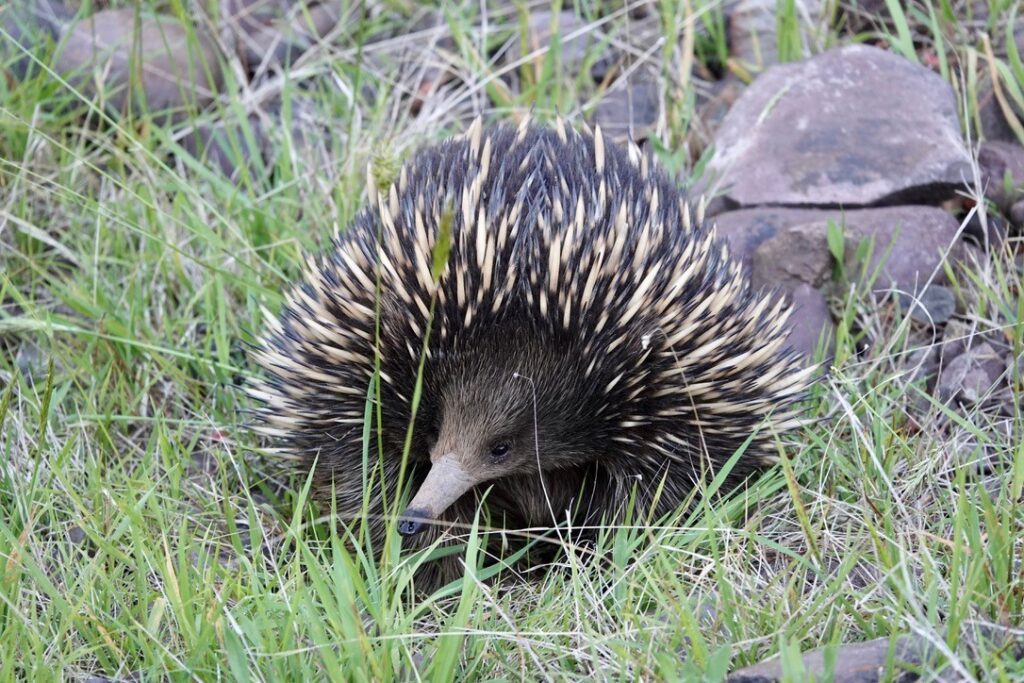
Platypus (Ornithorhynchus anatinus)
Seen occasionally in local creeks and rivers. Known from Campbells Creek and other rivers with near permanent water flows. Listed as vulnerable in Victoria. Sightings should be reported to the Australian Platypus Conservancy
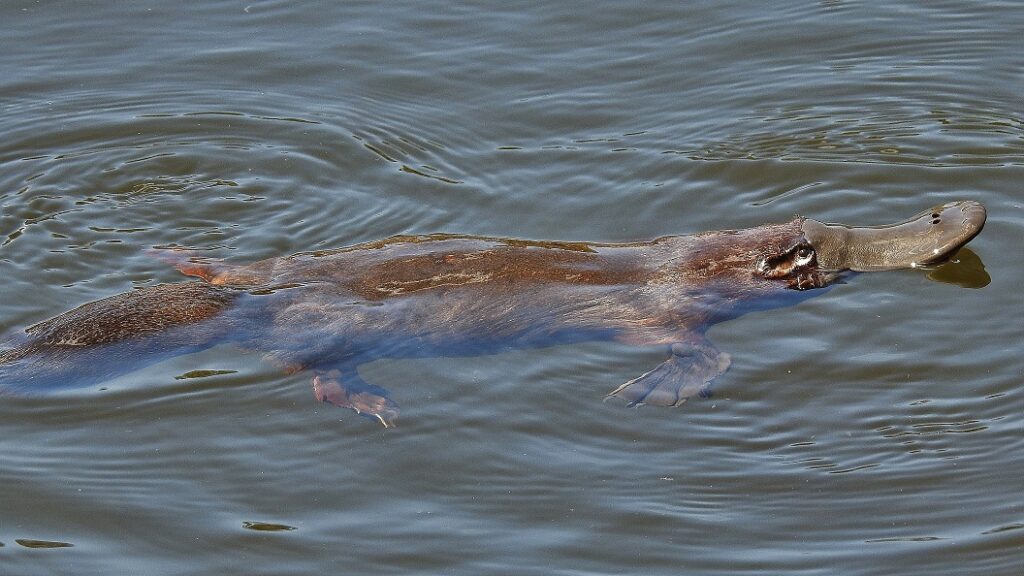
Marsupials
Brush-tailed Phascogale; Tuan (Phascogale tapoatufa)
A marsupial species, small, shy and nocturnal, that nests in trees. Listed as vulnerable in Victoria. Conservation programs are underway in an attempt to build numbers. This includes the provision of nest boxes to compensate for the lack of tree hollows.
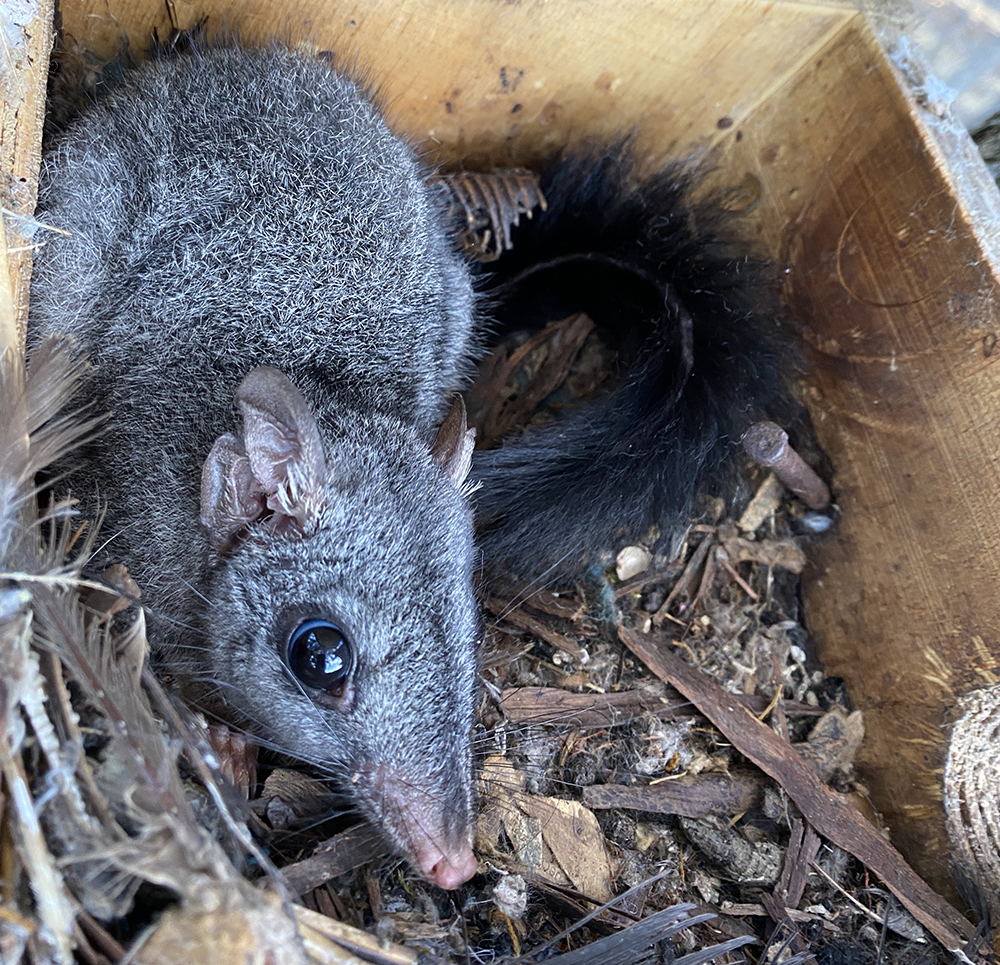
Yellow-footed Antechinus (Antechinus flavipes)
A widespread and abundant carnivorous marsupial found in a range of habitats. Mainly nocturnal and crepuscular but often seen during the day foraging around trees and fallen branches.
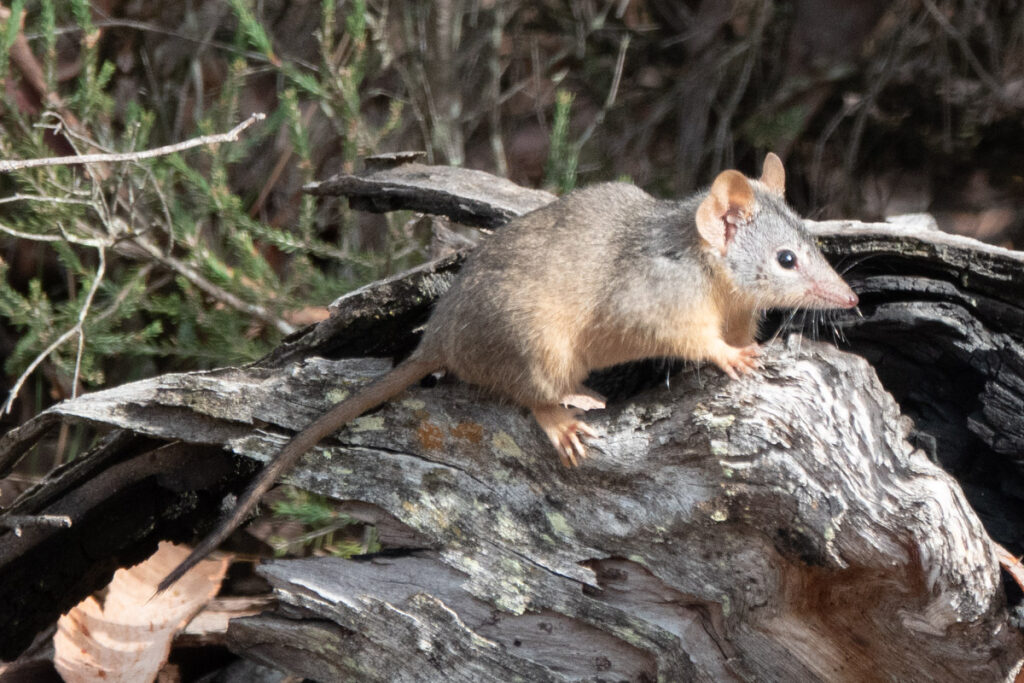
Common Dunnart (Sminthopsis murina)
This small nocturnal, terestrial carnivorous marsupial was recorded recently near Metcalf, east of Castlemaine. It is somewhat mouse-like and smaller than the Yellow-footed Antechinus.
Koala (Phascolarctus cinereus)
An uncommon marsupial. Found in open forests and woodland and usually solitary.
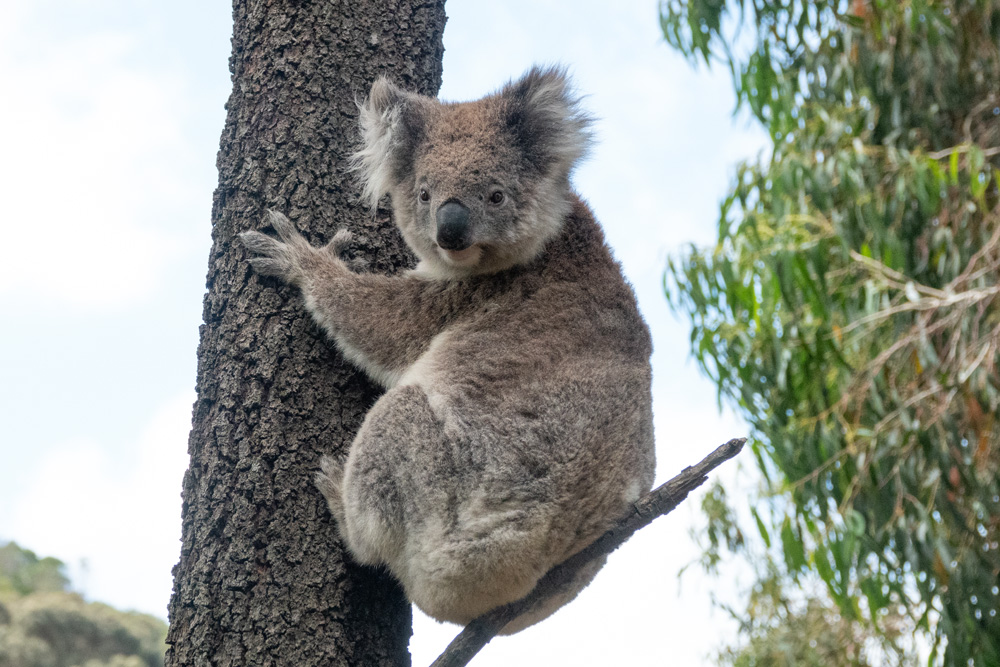
Common or Bare-nosed Wombat (Vombatus ursinus)
Wombats may be found in the cooler, wetter forests in the southern part of our region. Recently there have been sightings in the Chewton area where some have been caught by a wildlife camera.
They are mainly nocturnal.
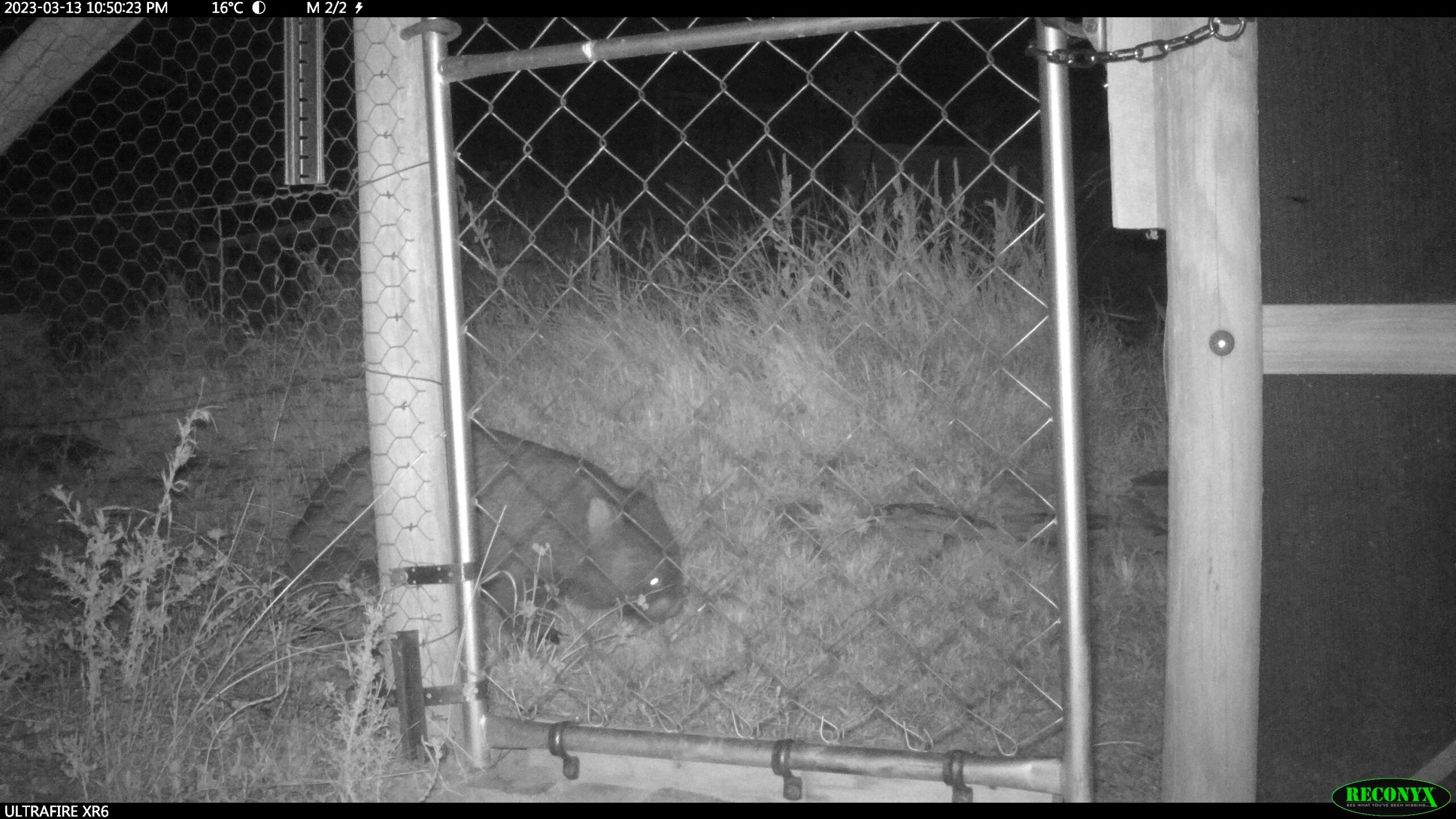
Common Brushtail Possum (Trichosurus vilpecula)
A widespread, nocturnal arboreal marsupial. It is common in both urban and bushland settings. The tail is thick and bushy.
It is about the same size as a domestic cat.
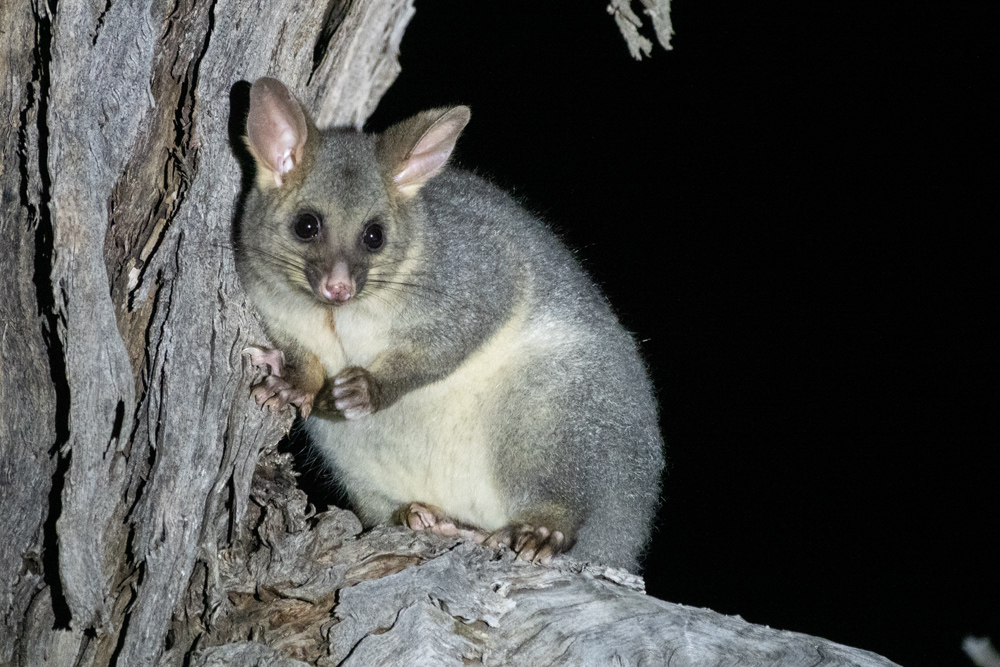
Eastern Pygmy Possum (Cercartetus nanus)
This species has been recorded near Fryers Ridge. It is an arboreal, nocturnal, mouse-sized marsupial that feeds on nectar, pollen, fruit and arthropods.
Greater Glider (Petauroides volans)
Greater Gliders are found in the Wombat Forest in the southern part of our region where they inhabit tall, wet forests. Thise is the largest of the gliding marsupials. It is about the size of a domestic cat with long shaggy fur and a long bushy tail. It spends daylight hours in tree hollows emerging after dusk to feed on eucalypt leaves. This species is listed as Endangered under the EPBC Act. In our area the main threat that it faces is loss of habitat.
Common Ringtail Possum (Pseudocheirus peregrinus)
A widespread, nocturnal and arboreal marsupial, found in both urban and bushland settings. Easily distinguished by the white terminal band to the tail.
It is about half the size of the Common Brushtail Possum.
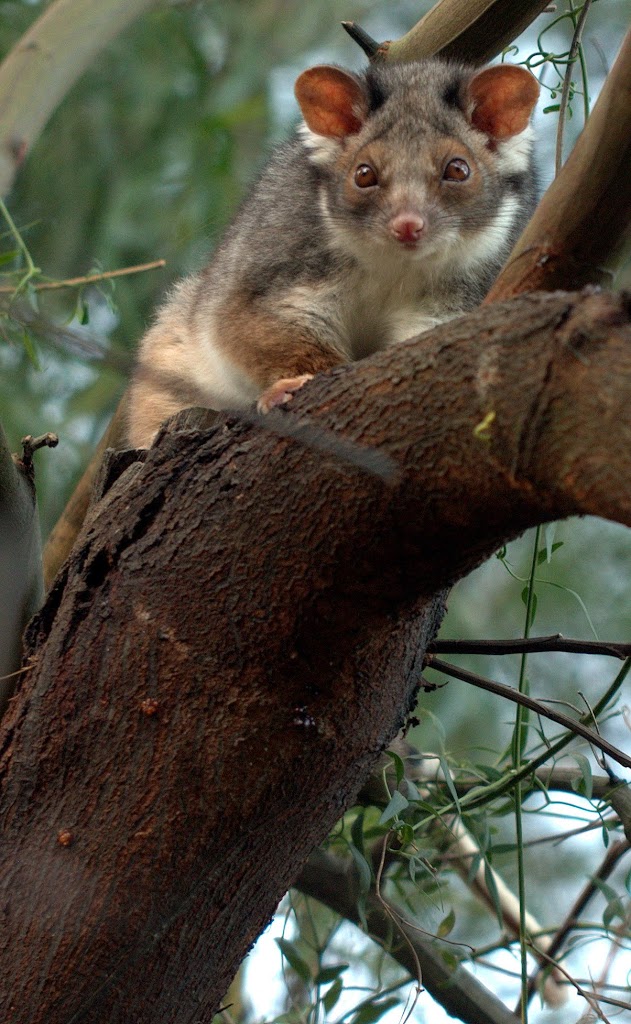
Photo: Ian Higgins
Krefft’s (Sugar) Glider (Petaurus notatus)
A small nocturnal gliding possum that is relatively common in the region. It is sometimes seen within urban areas. Family groups may occupy nest boxes as shown in the photo (right).
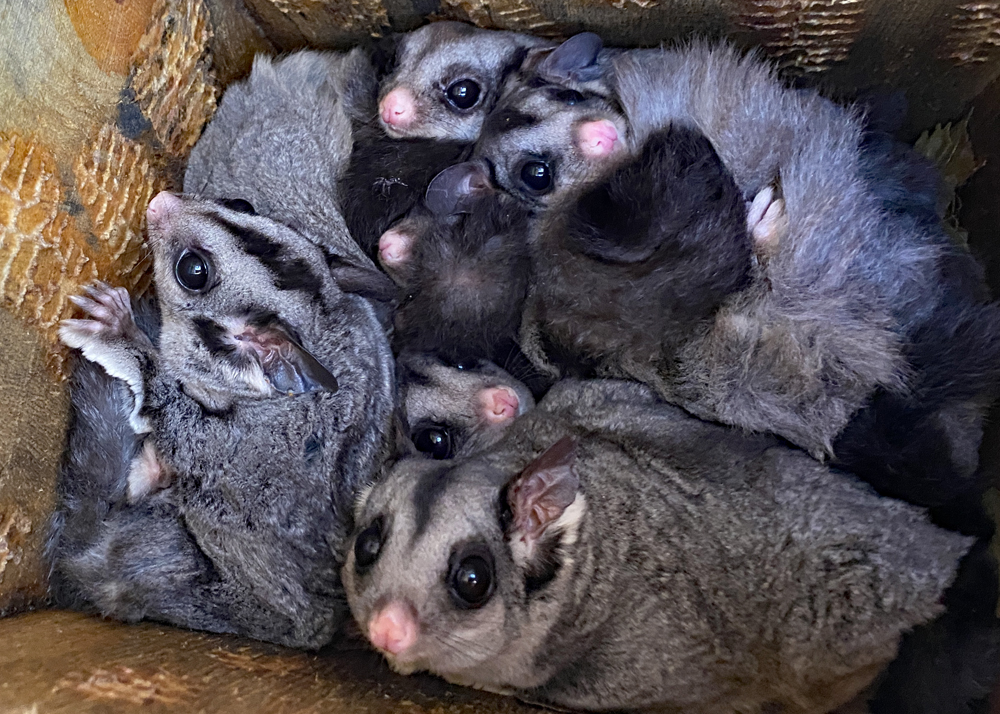
Feathertail Glider (Acrobates spp.)
This is the smallest of the gliding possums. There are two species in our region which are very difficult to separate in the field. Most records are from the southern part of the region however its small size and nocturnal habits mean that it will be often overlooked. It is sometimes found in nest boxes.
Eastern Grey Kangaroo (Macropus giganteus)
This is the common kangaroo for our area. Large numbers may be seen close to Castlemaine where they come out of the bush to graze on open paddocks in the late afternoon.
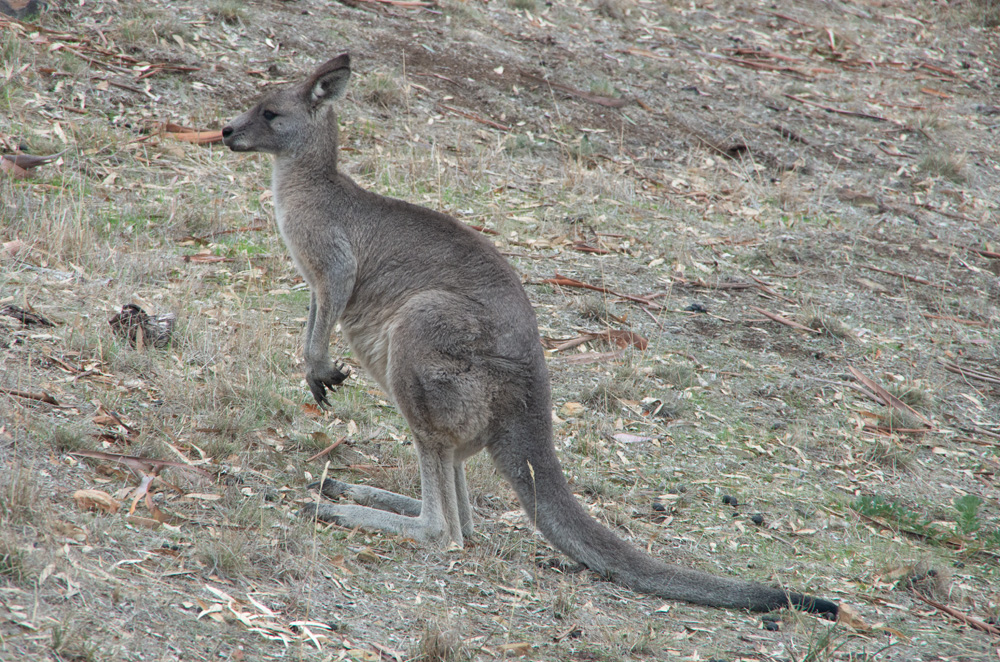
Swamp Wallaby; Black Wallaby (Wallabia bicolor)
A relatively common marsupial, smaller than the Eastern Grey Kangaroo. It is generally nocturnal and crepuscular, but also sometimes active during the day. Most often seen in areas of thicker scrub and undergrowth such as damp gullies. Usually solitary.
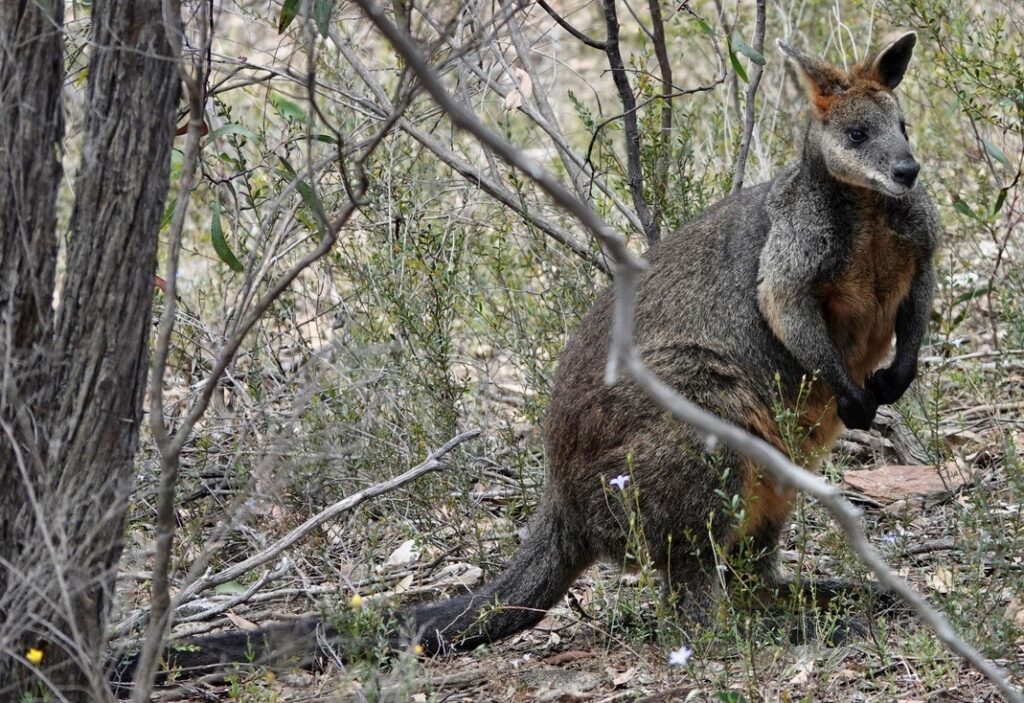
Placental Mammals
Grey-headed Flying-fox, Grey-headed Fruit-bat (Pteropus poliocephalus)
These are the largest bats in our area. They live in extensive colonies and range widely in search of the fruit that they eat. They have been seen locally feeding on plums and figs. A few individuals occasionally roost in the Castlemaine Botanic Gardens. The nearest colony is in Bendigo.

Lesser Long-eared Bat (Nyctophilus geoffroyi)
This is a common bat in our area that will often roost in protected locations around the house such as, in this case, a folded sun umbrella.
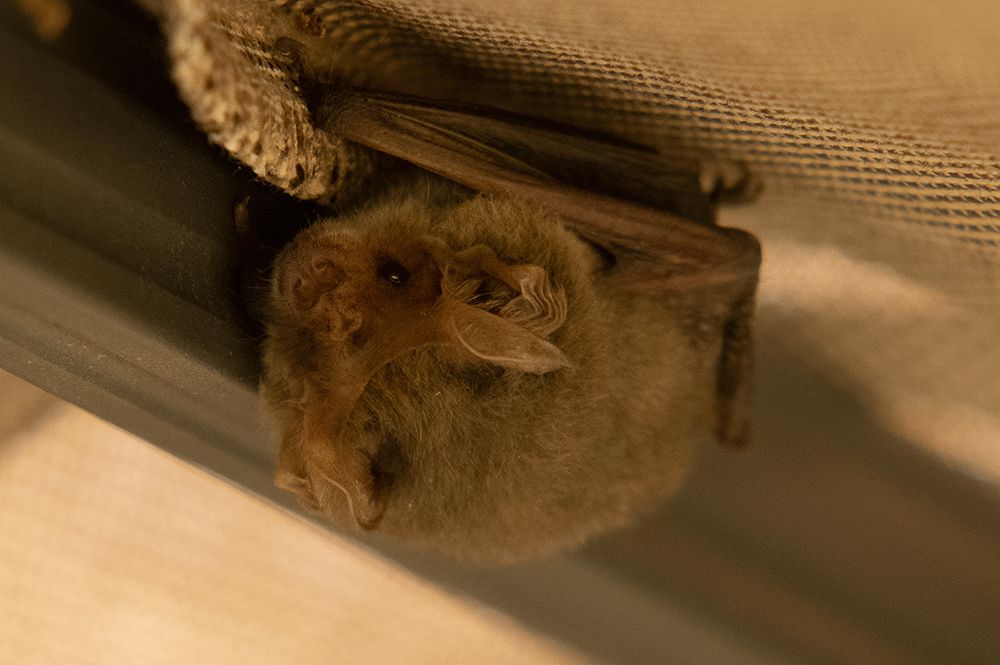
Other Microbats
These small insectivorous bats make up the largest group of mammals in our region with about a dozen species having been recorded. They mostly inhabit tree hollows or fissures in the bark of trees although some may use caves and old mine tunnels. Sometimes they are found in the roofs and other dark sheltered places in buildings. They are important for controlling insects in both urban and rural environments. You are most likely to see them silhouetted against the night sky shortly after sunset or hawking for insects around street lights.
Rakali; Water Rat (Hydromys chrysogaster)
An uncommon and rarely sighted semi-aquatic rodent that nests in the banks of waterways and is most active early in the morning. Often their presence is indicated by their “feeding tables”, logs extending above water level where they bring their yabbie prey to eat and leave the empty broken yabbie shells on the log.
More information about the Rakali and how to report sightings to improve distribution records can be found on the Australian Platypus Conservancy website.
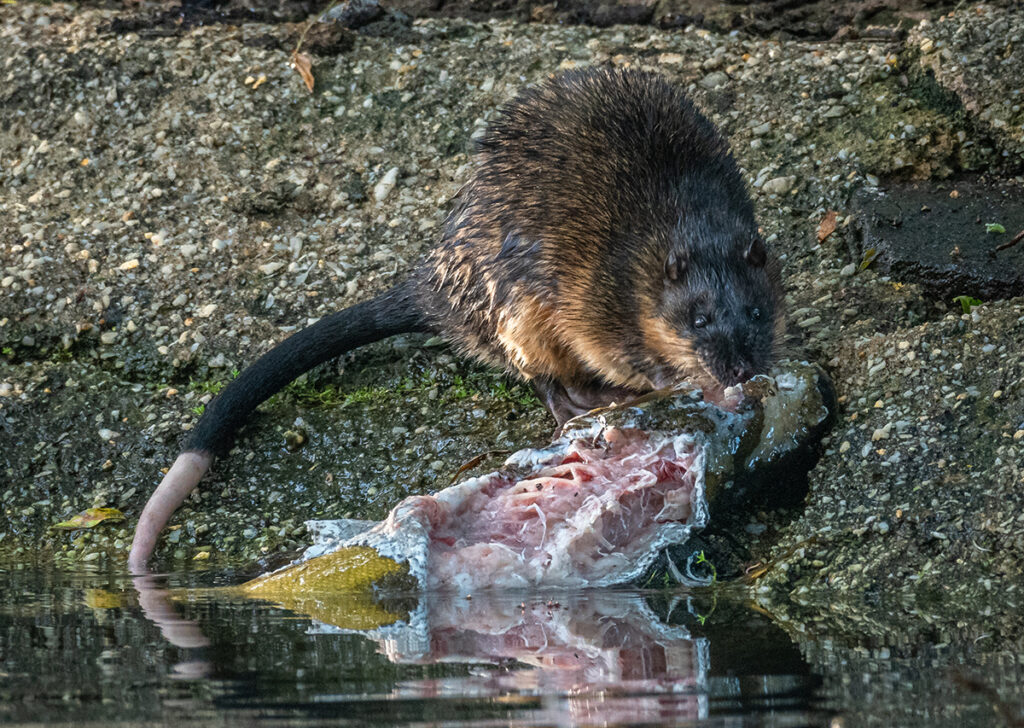
Feral animals
As with most other areas of Australia, this district suffers from the depredations of a number of feral animals, including hares, rabbits, foxes, feral cats and fallow deer. It is important that the presence of feral animals is recorded as this helps with the management and control of these species. Sightings of feral animals can be reported on FeralScan which feeds data into state-based feral animal control programs.
Checklist
This Checklist of Mammals of the Mount Alexander region is based on observations for the region recorded in the Atlas of Living Australia.
Local status is derived from the number of records along with local knowledge from naturalists in our area. The values are: R – Rare; UC – Uncommon; LC – Locally Common; MC – Moderately Common; C – Common; V – Vagrant.
Species with a * following the name are introduced.
| Common Name | Scientific Name | Local Status | Notes |
|---|---|---|---|
| MONOTREMATA | |||
| Platypus | Ornithorhynchus anatinus | UC | Found in Campbells Ck and Loddon River |
| Short-beaked Echidna | Tachyglossus aculeatus | C | Most habitats |
| DASYUROMORPHIA | |||
| Brush-tailed Phascogale | Phascogale tapoatafa | LC | Box-Ironbark forests with good leaf litter layer |
| Agile Antechinus | Antechinus agilis | LC | In the most southern part of our region |
| Yellow-footed Antechinus | Antechinus flavipes | C | Box-Ironbark forests. May enter the home |
| Mainland Dusky Antechinus | Antechinus mimetes | R | In the most southern part of our region |
| Common Dunnart | Sminthopsis murina | R | |
| DIPROTODONTIA | |||
| Koala | Phascolarctos cinereus | R | |
| Common Wombat | Vombatus ursinus | LC | In the most southern part of our region |
| Mountain Brushtail Possum | Trichosurus cunninghami | LC | In the most southern part of our region |
| Common Brushtail Possum | Trichosurus vulpecula | C | |
| Eastern Pygmy-possum | Cercartetus nanus | MC | |
| Feathertail Glider | Acrobates spp. | C | Two species found in this area. Difficult to separate in the wild. |
| Krefft's (Sugar) Glider | Petaurus notatus | C | Previously included with P.breviceps |
| Greater Glider | Petauroides volans | UC | In the most southern part of our region |
| Common Ringtail Possum | Pseudocheirus peregrinus | C | |
| Eastern Grey Kangaroo | Macropus giganteus | C | |
| Swamp Wallaby | Wallabia bicolor | C | |
| CHIROPTERA | |||
| Grey-headed Flying-fox | Pteropus poliocephalus | UC | |
| Little Red Flying-fox | Pteropus scapulatus | V | |
| White-striped Freetail-bat | Austronomus australis | C | |
| Little Mastiff-bat | Ozimops planiceps | MC | |
| Gould's Wattled Bat | Chalinolobus gouldii | C | |
| Chocolate Wattled Bat | Chalinolobus morio | C | |
| Large Forest Bat | Vespadelus darlingtoni | C | |
| Eastern Forest Bat | Vespadelus pumilus | R | No recent records. Locally extinct? |
| Southern Forest Bat | Vespadelus regulus | MC | |
| Little Forest Bat | Vespadelus vulturnus | MC | |
| Eastern False Pipistrelle | Falsistrellus tasmaniensis | LC | In the most southern part of our region |
| Lesser Long-eared Bat | Nyctophilus geoffroyi | C | |
| Gould's Long-eared Bat | Nyctophilus gouldi | LC | In the most southern part of our region |
| RODENTIA | |||
| Water-rat | Hydromys chrysogaster | UC | |
| House Mouse * | Mus musculus | C | |
| Bush Rat | Rattus fuscipes | LC | In the most southern part of our region |
| Swamp Rat | Rattus lutreolus | LC | In the most southern part of our region |
| Brown Rat * | Rattus norvegicus | R | |
| Black Rat * | Rattus rattus | C | |
| CARNIVORA | |||
| Feral Dog * | Canis familiaris | R | |
| Red Fox * | Vulpes vulpes | C | |
| Feral Cat * | Felis catus | C | |
| LAGOMORPHA | |||
| Brown Hare * | Lepus capensis | C | |
| Rabbit * | Oryctolagus cuniculus | C | |
| ARTIODACTYLA | |||
| Feral Goat * | Capra hircus | UC | In the most southern part of our region |
| Pig * | Sus scrofa | R | |
| Red Deer * | Cervus elaphus | R | Records from the south of our region. Likely to be increasing in numbers |
| Sambar * | Cervus unicolor | R | Likely to be increasing in number |
| Fallow Deer * | Dama dama | UC | Increasing in number |
Further reading:
Baker, K., Birkenbeil, A., Nicholas, H., Native Plants and Animals of the Chewton Bushlands, Chewton, Chewton Bushlands Asssociation, 2017.
Menkhorst, P., Knight, F., A Field Guide to the Mammals of Australia, Third Edition. Oxford University Press, 2010.
Tzaros, Chris, Wildlife of the Box-Ironbark Country, Melbourne CSIRO Publishing, 2021.